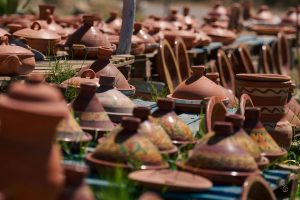Moroccan handicrafts are a beautiful representation of North African culture, combining artistry with practical use. These timeless crafts have been handed down from master to apprentice for generations, and they reflect the country’s rich history and skillful craftsmanship. Whether you’re exploring the vibrant markets of Morocco or adding a unique piece to your collection, these handicrafts are much more than souvenirs—they are functional works of art.
Leatherwork: A Symbol of Moroccan Craftsmanship
Leather products are a prominent feature of Moroccan handicrafts. In cities like Fez and Marrakech, you’ll find entire neighborhoods dedicated to the art of leather making. From stylish bags and soft leather slippers to durable document holders and colorful poufs, leather goods serve both a practical and aesthetic purpose. The tanneries, especially in Fez, are a must-see if you want to witness the traditional process of leather tanning.
Carpets and Blankets: Woven Wonders of Morocco
When it comes to Moroccan handicrafts, carpets and blankets are some of the most popular items. Known for their intricate designs, the carpets vary in size, color, and pattern depending on the region. Handwoven blankets, made of wool, offer warmth and a beautiful addition to any home. Whether it’s a natural tone or a bold pattern, Moroccan textiles have something to offer every taste.
Metalwork: Intricate Craftsmanship in Every Piece
The metalwork in Morocco is another marvel that highlights the country’s craftsmanship. Items like candlesticks, trays, lanterns, and door knockers are crafted with exquisite detail using materials such as brass, copper, and iron. Particularly notable is the art of Damascene ware, which originates in Meknes, and features delicate designs etched into metals. These pieces are perfect for adding an exotic touch to your home.
Wood Carving and Marquetry: The Art of Intricate Design
Moroccan wood carving is another significant craft, with intricate designs found in furniture, chessboards, plates, and other household items. Marquetry, the art of inlaying wood with materials like mother-of-pearl, creates stunning patterns on furniture and decorative pieces, making them a centerpiece in any room.
Pottery and Ceramics: Timeless Craft from Ancient Techniques

Pottery has been a staple of Moroccan culture for centuries. From simple bowls and cups to ornate tagines and vases, Moroccan pottery and ceramics are crafted with care and artistry. You’ll find a wide variety of earthenware, often decorated with intricate designs that reflect the country’s Moorish and Berber influences.
Basketwork: Weaving the Beauty of Moroccan Tradition
One of the most versatile Moroccan handicrafts is basketwork. Baskets come in all shapes, sizes, and colors, and are used for a wide range of purposes. From tightly woven water-holding baskets to soft and flexible ones ideal for storing linens, the craftsmanship behind each basket is evident in its beauty and functionality.
Jewelry: Fine Craftsmanship in Every Piece
Moroccan jewelry, from intricate metal pieces to colorful beaded designs, is both beautiful and unique. Whether it’s a silver medallion or an elaborate necklace, each piece of jewelry carries a story of craftsmanship passed down through generations. The designs often reflect the region where they originate, making each piece a personal connection to Morocco’s cultural history.
Architectural Craftsmanship: More Than Just Buildings
While the markets are full of hand-crafted goods, Morocco’s architecture is also a testament to its rich artisanal heritage. From the grand Hassan II Mosque in Casablanca to the fine tilework and stonework found throughout the country, Moroccan architecture embodies the same attention to detail seen in its handicrafts.
Conclusion
The handicrafts of Morocco are more than just souvenirs—they represent a culture rich in tradition and craftsmanship. Whether you’re interested in leather goods, intricate metalwork, or vibrant carpets, Moroccan handicrafts offer something for everyone. When you purchase one of these items, you’re not only bringing home a beautiful piece of art, but you’re also preserving the history of a rich and ancient craft.









